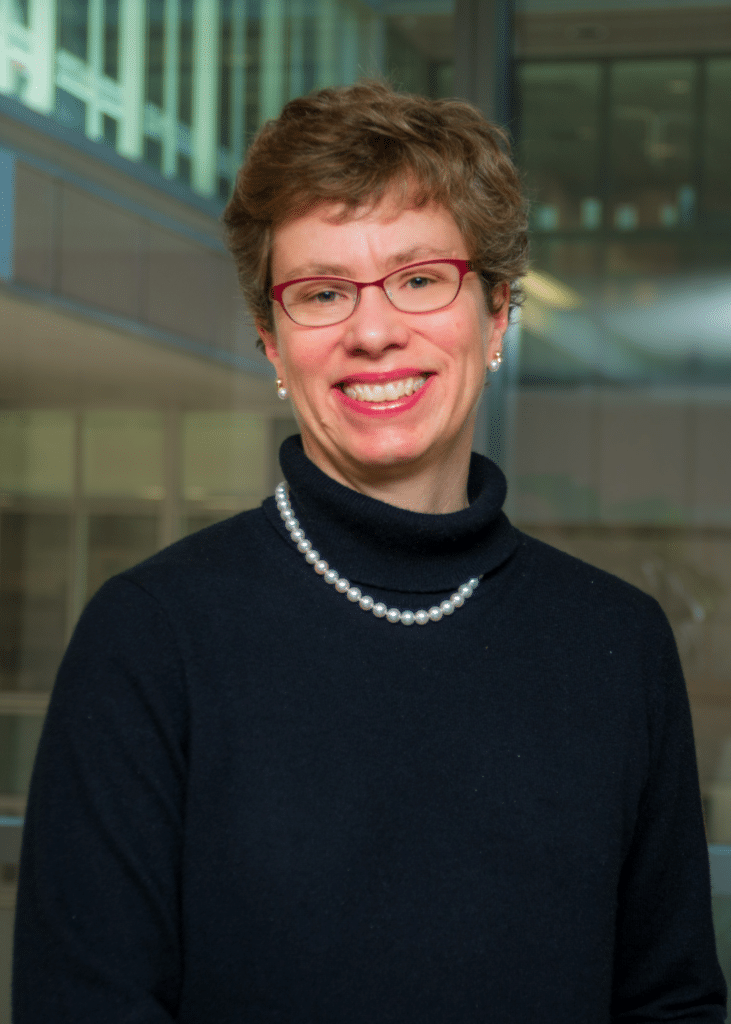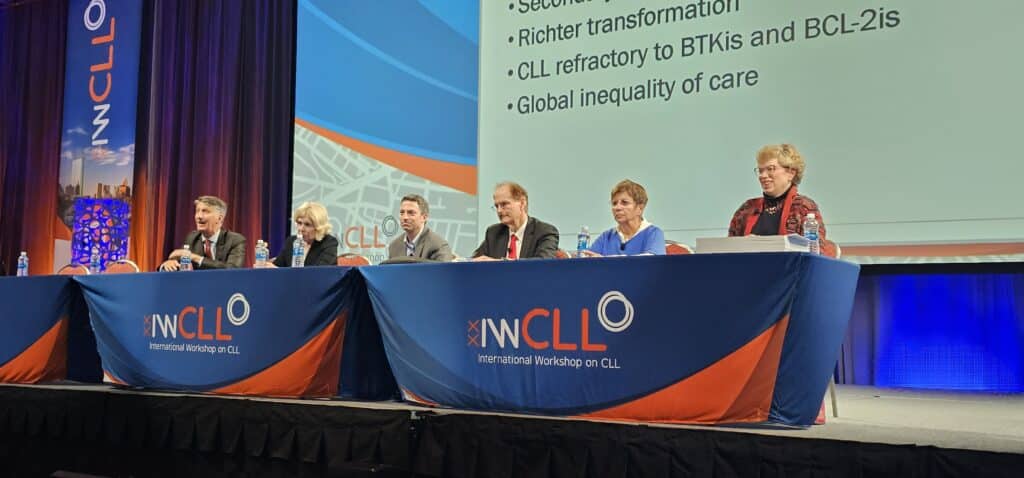Researcher Spotlight: Jennifer Brown, MD, PhD

Dr. Jennifer Brown, the Worthington and Margaret Collette Professor of Medicine in the field of hematologic oncology at Harvard Medical School and Director of the CLL Center and Institute Physician at Dana-Farber Cancer Institute (DFCI), has dedicated her career to understanding and treating lymphoma, particularly chronic lymphocytic leukemia (CLL). For over 20 years, Dr. Brown has led teams at Dana-Farber to new understandings of CLL and run clinical trials that have improved outcomes for countless patients.
Impacting People
When she’s not exploring the jungles of Uganda, climbing Machu Picchu with her husband, or swimming in the Atlantic Ocean near her beach house in the summer, Dr. Brown is solely focused on her patients and her research. Science has always been a particular passion for Dr. Brown. Growing up on Long Island, she was the first in her family to pursue a career in medicine.
“I got very interested in genetics in high school and have been strongly oriented toward science from then on,” she says. “Specifically, I was interested in the control of cell growth, and that lends itself to oncology and cancer in general.”
While attending medical school, she developed a fascination with hematology and majored in molecular biophysics and biochemistry (MB&B). Her early research focused on knocking out genes involved in growth control within cell lines. Her research helped her understand the genetic abnormalities of unregulated cellular growth compared to normal cells, which have practical applications in the study of lymphoma.
After enrolling in the Harvard Medical School dual-path MD/PhD program, Dr. Brown discovered the draw of hematology. During her fellowship, she found her affinity for studying malignant hematology and lymphoma. The heterogeneity of lymphoma and the clinical and biological variety appealed to her. She came to respect the varied patient experiences, too, and developed a sensitivity to the challenges that people go through when faced with a lymphoma diagnosis.
“At the time, medicine felt broader, while scientific research was feeling more and more narrow,” said Dr. Brown. “I wanted to have an impact on people, and due to the many subtypes of lymphoma, there are a lot of different patient experiences, which, in turn, offer a wide variety of experiences to a healthcare provider. I liked that, so that’s how I got into lymphoma.”
Working on the PhD part of her dual degree showed her how important the research side of the care equation was to her and how she could have a greater impact on medicine through research, especially her chosen specialty of improving the lives of lymphoma patients.
During her medical residency at Massachusetts General Hospital, she joined the hematology and medical oncology division at the Dana-Farber Cancer Institute. While there, she worked with a mentor in a small lab, participating in a program known as the Clinical Investigator Track, which was created for people who take care of patients and run clinical trials.
From her fellowship, she joined the faculties of DFCI and Harvard Medical School, and in 2021, she was awarded an endowed professorship at the medical school.

Investigating Novel Treatments
Dr. Brown’s research is centered around improving treatment options for chronic lymphocytic leukemia (CLL), a type of cancer that starts in the bone marrow and affects the blood. She is working on understanding why and how certain CLL cells become resistant to treatments over time as well as why people get CLL and the inheritance of it at the genetic level.
“My day-to-day schedule is a mix of seeing patients and managing research,” said Dr. Brown. “I have one full day of clinic each week, and the other days are a mixture of running the lab, advising my people in the lab, dealing with issues with clinical trials, and getting the clinical trials through the institutional review process. Currently, I’m working on getting two clinical trials going that have arisen from research we’ve done in the lab. So that’s exciting.”
A key element of her current research involves studying BTK inhibitors, a class of drugs that target a protein called Bruton’s tyrosine kinase (BTK). BTK plays a crucial role in the development of B cells (white blood cells). Drugs that inhibit BTK can effectively shrink cancerous lymph nodes to manage the disease. However, not all patients respond to these treatments in the same way, and some eventually develop resistance to the drugs.
“What’s interesting is that patients’ white blood cell counts sometimes went up, which was very counterintuitive, and no one understood why,” explained Dr. Brown. “But we came to understand that it appeared to be a redistribution phenomenon rather than disease progression. This evolved into a novel response criterion where the white count going up was no longer a sign of progression.”
As Dr. Brown was working on identifying why drug resistance happens, her team discovered that in many cases, when BTK inhibitors stop being effective, it’s because the cancer cells have found ways to activate proteins that bypass the drug’s effects.
A Crucial Resource
A pivotal component of Dr. Brown’s lymphoma research is DFCI’s extensive CLL tissue bank that has over 3,500 patients enrolled and more than 20,000 individual stored samples. Started over 25 years ago, the tissue bank is foundational for the groundbreaking work done at DFCI. Dr. Brown took the leadership role for the CLL bank when she joined DFCI faculty in 2004. Ever since she started working with it, she has spearheaded the collection of serial samples from patients – samples from them before, during, and after their treatment – even patients not in trials with targeted inhibitors.
“What is really novel about our tissue bank is the extensive clinical annotation that we have,” said Dr. Brown. “We have all the clinical data for all the patients, all the prognostic markers. There is a lot of interest in the evolution of cancer under the influence of different drugs, and with serial samples, we have the opportunity to study that because we have the whole natural history of the disease.”
The tissue bank supports the development of precision medicine. By analyzing the stored samples, Dr. Brown’s team can identify specific genetic profiles and biomarkers that predict how a patient’s disease will respond to different treatments. This insight allows for personalized treatment plans tailored to each patient’s cancer.
The CLL Patient Experience
In addition to developing therapies for CLL, Dr. Brown also wants to understand why people get CLL in the first place. While there is a strong hereditary component to developing CLL, it’s a highly variable disease. Some genetic mutations are common to many CLL patients, while others are rare or individualized, suggesting multiple genetic contributions to CLL. This complicates the search for universal genetic markers for CLL and points to the development of personalized, targeted approaches to prevention and treatment.
Dr. Brown knows that when markers for CLL are discovered in a patient, it’s likely a highly traumatic event for them. But she reminds us that living with CLL, even when it is manifesting in the patient, is different than it was years ago. Today’s treatment for the disease is far more effective than what was available previously, even though there is no outright cure for CLL today.
She notes that today, people can get diagnosed early with the disease, and they usually don’t have any symptoms and may not develop any for years. Multiple treatment options are available to patients based on several factors, not the least of which is what the patient wants. The most critical issue for patients is monitoring and caring for their immune systems, as CLL puts them at greater risk for infections and secondary cancers.
“The important thing is to have a conversation with the patient to understand what their priorities and goals are and how different treatments will work,” she says.

Lymphoma Research Foundation on Her Side
Dr. Brown notes that the Lymphoma Research Foundation has been at her side for over 15 years. The Foundation has provided her with several research grants that have been instrumental in allowing her to explore innovative treatment strategies for CLL. The Foundation has also been an active partner in patient communication and education critical to maintaining the two-way dialog central to long-term research challenges.
Today, Dr. Brown is a member of the Foundation’s Scientific Advisory Board (SAB) and is a senior advisor for the Foundation’s CLL Working Group. The group is currently finishing a paper that will help guide physicians regarding managing CLL.
“The Foundation does great work for patients as well as for researchers,” she notes. “I encourage all in the lymphoma field to seek out their counsel and potential grants whenever possible. I’m proud to be on the Scientific Advisory Board and work with a great group of people moving us closer to cures for the diseases that don’t yet have cures.”
Dr. Brown is optimistic about the future of CLL research and feels grateful to play a part in ensuring a brighter future for all those affected by this disease.
“There’s still so much we need to understand,” said Dr. Brown. “We have the potential to cure people, and we have many new kinds of treatments for CLL that are just in their infancy of being studied. It’s an exciting time to be in lymphoma research.”
Read More Articles from Pulse
Pulse is a publication of the Lymphoma Research Foundation, providing the latest updates on the Foundation and its focus on lymphoma and chronic lymphocytic leukemia (CLL) research, awareness, and education

